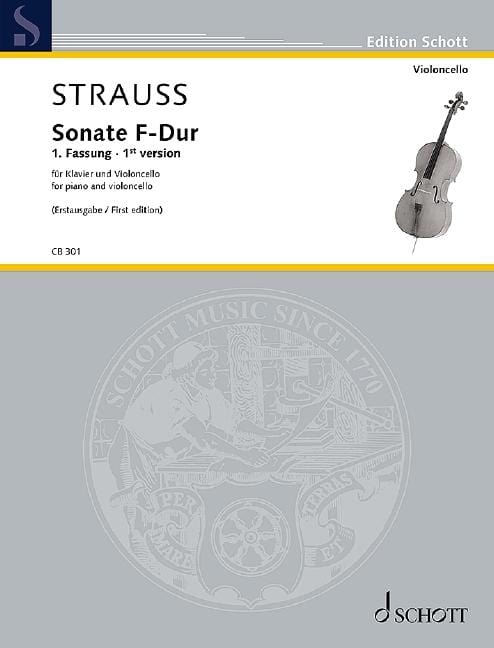
Sonate F-Dur (First edition of 1st version) for piano and violoncello 史特劳斯理查德 钢琴大提琴 大提琴加钢琴 朔特版
大提琴奏鸣曲作品 6 的创作历时三年之久,这对于斯特劳斯早期的创作阶段来说是非常漫长的。作曲过程中产生了两个独立的版本,其中第一个版本首次以《理查德-施特劳斯作品批判版》(Critical Edition of the Works of Richard Strauss)中的文本为基础,作为实用音乐文本出版。这两个版本的起源和修改原因只能部分还原:现存的亲笔签名中只有一个注明了日期,第二个版本仅存印刷本。两个版本的奏鸣曲存在巨大差异:施特劳斯删去了整个第二和第三乐章 "大步 "和 "活泼快板",代之以新创作的 "安魂曲 "和 "终曲"。在第一乐章 "小快板 "中,施特劳斯几乎原封不动地在新版奏鸣曲中保留了主题动机材料和复杂的作曲段落,如发展部的三声部赋格(第一版为第 241 小节,第二版为第 275 小节),但也进行了大量改动,尤其是在钢琴声部的结构、乐章的主题动机发展以及和声方面,变得更加雄心勃勃12。特别值得注意的是,从第 32 小节开始的 con espressione 主题伴奏出现了重复,而第一版的发展过程则大大缩短。现在,理查德-施特劳斯大提琴奏鸣曲第一版的印刷版使我们有可能了解施特劳斯在这一时期的创作发展。两个版本之间的差异意义重大,这也意味着理查德-施特劳斯为大提琴和钢琴创作的两首奏鸣曲在基本特征上存在根本性差异,而现在这两首奏鸣曲都可以演奏了(摘自编者前言)"
作曲家: Strauss, Richard
编者: Eller, Florence / Pernpeintner, Andreas / Schenk, Stefan
乐器: cello and piano
出版社: Schott Music
原文简介:
The Cello Sonata Op. 6 was composed over an apparently frequently interrupted period of three years, an extraordinarily long time for Strausss early creative phase. The compositional process spawned two independent versions of the work, the first of which is published for the first time on the basis of the text in the Critical Edition of the Works of Richard Strauss in the current edition as a practical musical text. The genesis of the two versions and the reasons for revision can only be reconstructed in part: only one of the surviving autographs bears a date and the second version only survives in printed form. What is more, Strauss did not communicate in greater detail on this composition in correspondence with his family and friends.There are enormous differences between the two versions of the Sonata: Strauss deleted the entire second and third movements Larghetto and Allegro vivace, replacing them with a newly composed Andante and Finale. In the first movement, Allegro con brio, Strauss retained the thematic-motivic material and compositionally complex passages such as the three-voice fugue in the development section (from bar 241 in the first version and bar 275 in the second version) almost intact in the new version of the sonata, but also undertook extensive alterations, particularly in the structure of the piano part, the motivic-thematic development of the movement and its harmony which became far more ambitious.12 Particular attention should be drawn to the repetitive accompaniment of the con espressione theme beginning in bar 32 and the significantly shorter development in the first version.The current printed edition of the first version of Richard Strausss Cello Sonata now makes it possible to follow Strausss compositional development during this period. The significance of the differences between the versions also mean that two sonata compositions for violoncello and piano by Richard Strauss with fundamental disparities in their underlying character are now available for performance.(from the foreword by the editors)





